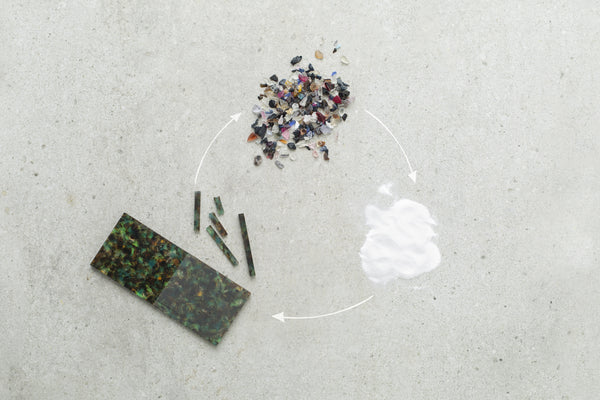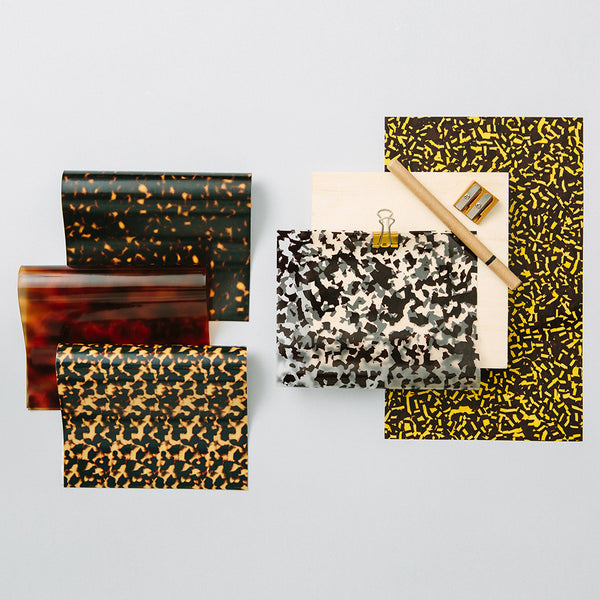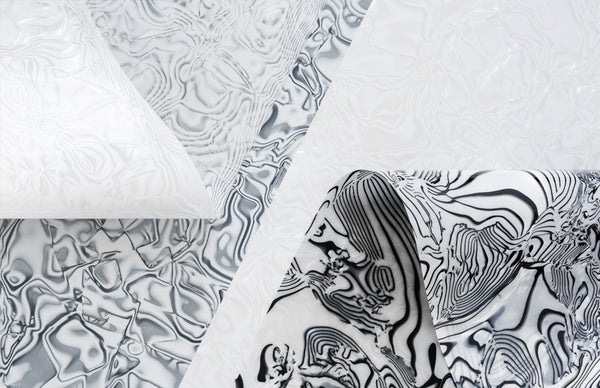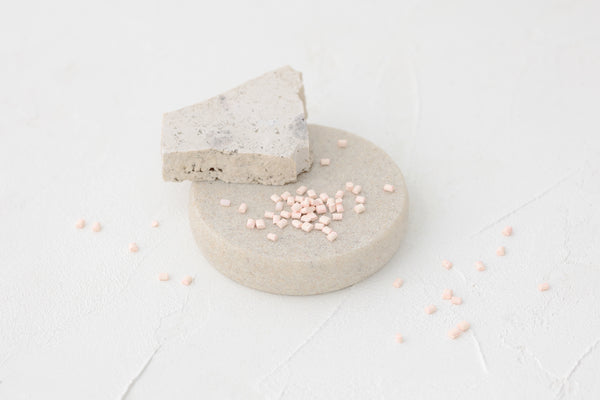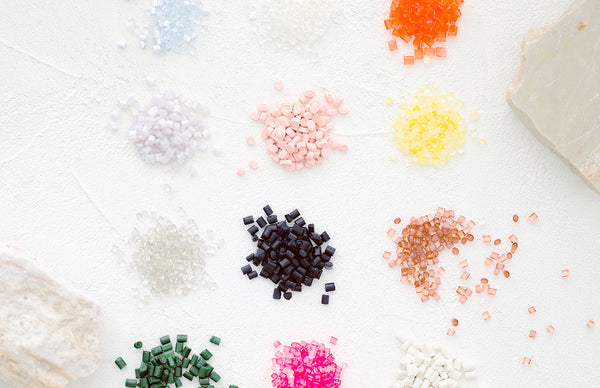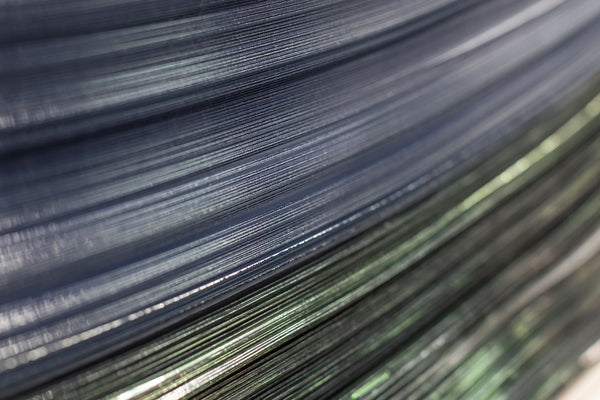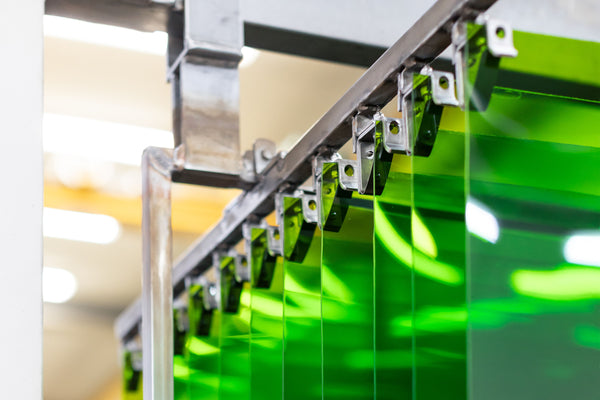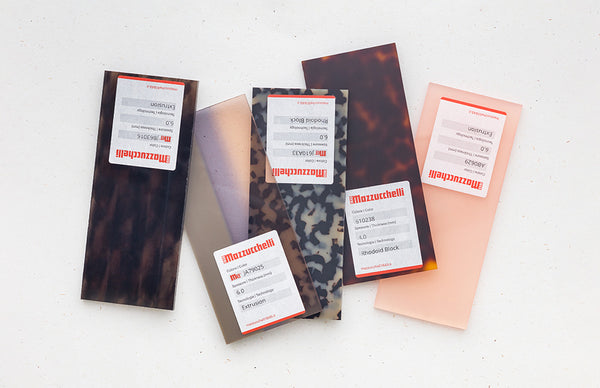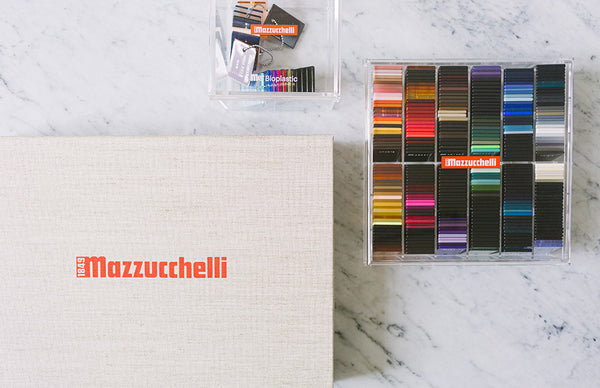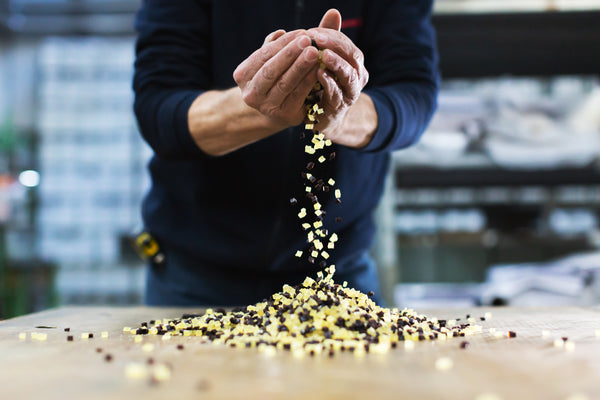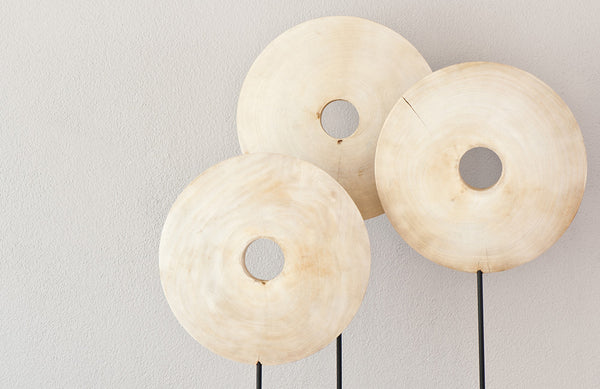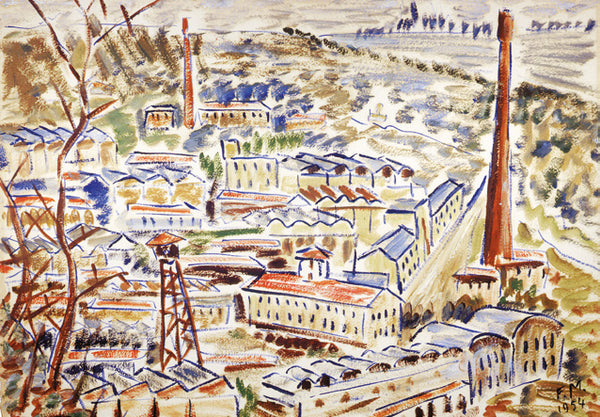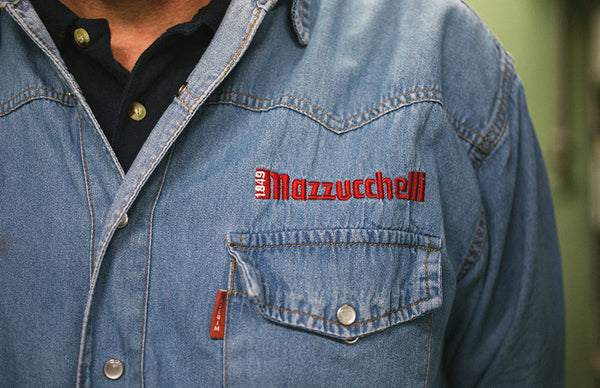Materials and processing
What is a slab
The slab is a semi-finished product made of cellulose acetate. Size 7 x 17cm. Slabs are sub-formats of our cellulose acetate sheets or strips.
They are supplied with a removable sticker with product code on it. Slabs have no text or holes to allow you to use their total surface.
To be transformed into the element you desire, slabs can undergo countless processes and finishes. Here below you may find suggestions for the processing.

Cellulose Acetate
Cellulose acetate is a modified natural polymer.
To obtain Cellulose Acetate we start with the selection of renewable sources such as certain varieties of trees and cotton linters.
From these sources the purest part of the cellulose is extracted which is subsequently treated with Acetic Anhydride and transformed into Cellulose Acetate powder.
Production processes: an overview
During Mazzucchelli’s processes, this powder is intimately mixed with substances aimed at giving the desired workability, flexibility and toughness: the so called plasticizers.
Other additives such as light and heat stabilizers (dyes and pigments) can be added in small quantities if necessary.
Formulations offered by Mazzucchelli for the slabs are:
- Standard formulation, plasticized with DEP;
- M49 formulation, or biobased. Phthalate plasticizer has been replaced by a proprietary plasticizing solution of vegetable origin.
The material proposed for the Creative Case is obtained through the following Mazzucchelli production processes:
- Block process: a process of sophisticated craftsmanship which, thanks to our decades of experience, allows us to obtain infinite aesthetic effects ranging from our iconic havanas to three-dimensional designs that reproduce natural effects, passing through fabric replication to reach geometric effects of great impact and complexity.
- Extrusion process: it is a typical process for plastic where granules of varied colors are melted and passed through a dye in which several distinct flows of molten material combine precisely creating the design on the material.
Cellulose acetate sheets, and therefore slabs, can be produced in an infinite range of transparent, milky or solid colors, monocolor or multicolor, with the possibility of aesthetic effects that make them irreplaceable in many applications and in particular as raw material for the production of eyeglass frames or high-end fashion accessories.
Characteristics
The following pages show the physical characteristics of the cellulose acetate slabs produced by Mazzucchelli, as regards process and formulation.
The information and values indicated here below, although coming from many years of experience, are purely indicative and do not constitute a guarantee of any kind.
Characteristic values of Cellulose Acetate sheets:
|
|
Norm Ref. |
U.M. |
Standard Formula |
M49 Formula |
| Tensile strength at yield |
ASTM D 638 |
Mpa |
26,2 |
25 |
|
Tensile strength at break |
ASTM D 638 |
Mpa |
36,5 |
36,9 |
|
Elongation at yield |
ASTM D 638 |
% |
3,8 |
4,5 |
|
Elongation at break |
ASTM D 638 |
% |
56,1 |
58,5 |
|
Elastic modulus |
ASTM D 790 |
Mpa |
1’613 |
1’380 |
|
Rockwell hardness |
ASTM D 785 |
R |
91,5 |
93 |
|
Izod impact resistance |
ASTM D 256 |
KJ/m2 |
13,1 |
11,4 |
|
Charpy impact resistance-average value |
ISO 179 |
KJ/m2 |
161 |
149 |
This table shows the average values for each formula as an indication of performance, they should not be considered as acceptability limits. Based on performance requirements, customer can choose between the various formulations.
Chemical resistance:
Cellulose Acetate slabs have a good resistance to water-based solutions dissolved with acids, bases and inorganic salts, paraffinic hydrocarbons, higher alcohols, oils and fats.When in contact with boiling water, surface whitening occurs. In order to heat the material for curving or mechanical deformation, as an alternative to the most common high frequency heaters, a heated bath of water and glycerine in equal parts is used (1:1).
When in contact with alcohols, aromatic hydrocarbons and chlorinated solvents, swelling or plasticizer loss occurs.
Material is soluble in ketones.
Acids and strong mineral bases, pure or concentrated oxidizing salts lead to chemical degradation.
Due to its chemical nature, cellulose acetate used for the production of such slabs has a tendency to absorb water.
The following graph illustrates the absorption or disabsorption following to an extended stay at a normal temperature (23°C) in environments with different levels of relative humidity. It can be noted that, in particularly humid environments (95% RH), the water intake tends to reach a humidity in the order of 5%; on the other hand, in a dry environment, a water content of a few units per thousand is reached.

Luckily, in practice, an extended stay in similar extreme conditions rarely occurs: the more usual case is shown by the following graph, in which it can be noted that, starting with either very humid or very dry material, staying in an atmosphere with 50% of RH, material tends to reach a balance humidity of 2%.

This last circumstance allows to have optimal conditions of material processing.
The water content, in fact, plays a significant role on the physical and mechanical properties:
- A high water content can greatly increase the impact resistance but makes the product soft, decreasing elastic modulus and thermal resistance.
- Sudden heating of the material can increase the vapor pressure of the water contained within causing the formation of bubbles; on the other hand forced drying can cause fragility.
Even dimensional characteristics can be influenced by the variation of the humidity content: drying provokes a slight contraction of the mass that is soon recovered by a stay in a suitably humid environment.
Biocompatibility
of Cellulose Acetate Sheets produced by Mazzucchelli 1849
According to Regulation (EU) 2017/745 on medical devices, frames with ophthalmic lenses fall under the category of medical devices class I.
In order to evaluate the biocompatibility of these medical devices a test protocol must be followed, as defined by the ISO 10993 standard which states its procedure.
Both the Regulation and the standard take into consideration many factors for a medical device to be considered biocompatible:
- Tradition of use;
- Scientific literature;
- In vitro or in vivo tests.
It should be noted that both the standard and the Regulation provide that it is the manufacturer of the medical device who is responsible for the certification of his product and not the producer of the raw material or semi-finished products.
Mazzucchelli, which has always been attentive to comply with all the regulatory and safety requirements of its materials, wanted to anticipate market considerations through an assessment of its products in the supply conditions, in such a way as to be able to support, with these evaluations, the possible certification activity of its customers.
Mazzucchelli has been producing, with proprietary formulas, Cellulose Acetate sheets since 1936 and has organized internally a structured and thorough method for the management and the evaluation of the substances and the collection of reports from the market. Mazzucchelli has also carried out the tests required by the ISO 10993 standard on the two main formulations (Standard Plasticized Material DEP and M49) with positive results and has submitted the entire documentation to medical consultants working in hospitals who, in turn, have provided favorable opinions on biocompatibility.
The whole documentation, through which it was possible to achieve these positive results, has been collected in an organized way in a dossier named "Profilo di sicurezza delle lastre di acetato di cellulosa Mazzucchelli " and will be made available, upon request, to the Authorities responsible for any verification of compliance with Regulation (EU) 2017/745.
The Anfao Association (Associazione Italiana Fabbricanti Articoli Ottici), with the help of a consultant in charge of performing an audit, has examined the dossier and has acknowledged Mazzucchelli's correct approach by positively evaluating the reported evidences.
The results of the work done by Mazzucchelli are exclusively valid for Cellulose Acetate sheets produced by all the companies belonging to the Group.
The foregoing only refers to Mazzucchelli products which has been supplied and is guaranteed by the ability to properly select and monitor the components used. In this regard, we point out that the aesthetic (albeit similar) reproductions of our products formulated by Mazzucchelli's competitors do not necessarily imply the use of the same components and therefore might not be as safe and suitable for the use in Class I medical devices.
Mazzucchelli therefore guarantees that its products, on the basis of the tradition of use, the extensive literature collected and the tests carried out, can be considered non-irritants and non-skin sensitising. Nevertheless, it cannot be ruled out that individual cases of irritation or skin sensitisation due to one or more constituents used may occur.
Processing
The working methods of Cellulose Acetate slabs are part of the know-how of eyewear manufacturers and depend partly on the technological solutions used.
However, we think it is appropriate to make operators aware of some phenomena that may affect the final quality of the products.
Note: Each phase must be performed with PPE suitable for the process conditions and instruments used.
Storage
The material used for the slabs we produce is a thermoplastic polymer which is hardly inflammable and therefore does not require any special safety precautions for storage.
As mentioned in the chapter "Characteristics", the temperature/humidity of the product plays an important role on the mechanical and workability characteristics; it is therefore important that slabs arrive at the processing phase in optimal conditions and this can be obtained with an appropriate preventive conditioning, or rather by ensuring that storage is carried out in environments with controlled temperature and humidity.
The best conditions of storage or conditioning are obtained at temperatures around 20-25° C and relative humidity of 45-55%.
As far as storage methods are concerned, horizontal stacking (of material in the original packaging – to be preferred to unpacked slabs) is the easiest and most acceptable method. To avoid differences between the external slabs of the pile and the central ones, it is suggested to condition slabs hanging one by one in appropriate racks for a couple of days, in the above mentioned temperature and humidity conditions, before starting the processing.
It is common to “flatten” slabs in an oven.
M49 suggestions for storage: for the correct storage of this product it is suggested to stack it separately from the standard plasticizing material. Under certain environmental conditions, where M49 slabs were stacked with standard plasticizing slabs, plasticizer migrations could be observed, mainly in the contact areas, which generate a superficial oiliness. If this phenomenon occurs, it is sufficient to leave the material in the air for a few hours. In doing so, the oiliness will be reabsorbed; alternatively you can use a clean cloth and remove it manually.
Planing
This kind of operation must be performed with very sharpened tools, with constant material feeding. Too high planing speeds may cause tears and defects on the surface of the material. It is suggested to planer the material by removing maximum 0.4mm for each passage of the planer, in case of thicknesses higher than 0.4mm it is suggested to balance the removal (for example in case of removal of 0.6mm it is suggested to remove 0.3mm per passage).
Cutting
The most common cutting methods are:
- Shearing
- Cutting with circular saw
- Laser cutting
For methods 1 and 2 it is recommended to use sharp tools to avoid chipped or defective edges. As regards cutting with a circular saw, it is suggested to use sharp blades with a thickness of 2 mm.
So far as shearing, it is preferable to work with material at a temperature above 20°C, it may be useful to slightly preheat the slabs to prevent any kind of defect.
It should be recalled that laser cutting is a thermal cut and the high temperatures used can degrade the polymer and lead to a loss of plasticizer with consequent vitrification and embrittlement of the material near the cutting area. Abrasion of a few microns of the laser-cut edge can reduce these fragility problems.
Cutting conditions may vary depending on the model and the laser source used.
As an indication but not exhaustive, the following laser cutting conditions are reported:
|
process/formula |
Speed cm/min |
Advance rate m/sec |
Power % |
Frequency % |
|
Std Block |
|
|
|
|
|
th. 30/10 |
350 |
6 |
15/90 |
3/6 |
|
th. 40/10 |
260 |
7 |
25/90 |
3/6 |
|
th. 60/10 |
150 |
5 |
20/90 |
3/6 |
|
th. 80/10 |
60 |
10 |
40/90 |
2/4 |
|
|
|
|
|
|
|
Std Extrusion |
|
|
|
|
|
th. 30/10 |
350 |
10 |
8/90 |
3/6 |
|
th. 40/10 |
260 |
7 |
25/90 |
3/6 |
|
th. 60/10 |
150 |
5 |
20/90 |
3/6 |
|
th. 80/10 |
50 |
5 |
40/60 |
2/4 |
|
|
|
|
|
|
|
M49 Formula |
|
|
|
|
|
th. 40/10 |
300 |
5 |
15/90 |
2/6 |
|
th. 60/10 |
130 |
5 |
40/90 |
2/4 |
|
th. 80/10 |
93 |
5 |
53/90 |
1/2 |
The technical characteristics of the machine with which tests of the cutting conditions were performed are:
optical rated power: 5÷115 W
typical maximum power: 135 W
wavelength emitted radiation: 10,4-11,2 µm
It should be remembered that cellulose acetate, coming from wood, has behaviors which are very similar to the latter and therefore typical tools for wood processing can be used, adapting the conditions of use, also for the processing of slabs.
Flattening
In case the slabs stored become curved, we suggest the following method:
- Position the metallic sheet (preferably a sheet of aluminium with a thickness of 1 mm) on the oven shelf.
- Place the acetate slab on the metallic sheet. If there is more than one acetate slab, alternate with metallic sheets (sandwich).
- Cover with another metallic sheet.
- Close the oven and heat for a minimum time of 4 hours to a maximum of 8 hours at 80°C (70°C for bleeding colors such as “soft havana patterns”).
- Allow to cool slowly until room temperature is reached.
In the event of non-optimum "flattening" it is better to lengthen the heating time. The above information is indicative and may need to be changed in time and temperature based on the equipment used. It is suggested to test your equipment and adapt the method on a single slab.
Milling
Optimal processing conditions of the material (standard formula or M49) occur when it has been previously conditioned at room temperature, preferably with a relative humidity of around 50%. Working materials at too low temperatures can give rise to chipping.
Before starting the processes to obtain the finished object (for example a pair of glasses or a bracelet), it is necessary to check the conformation and the geometry of the slab so as not to remove with the subsequent processing the layers necessary to the final aesthetic result.
It is important to evaluate slabs both in plan and in section.
More attention must be paid to the slabs obtained from the extrusion process. These slabs can in fact be composed of a different layers or of a superposition of elements which must be taken into account.
It should be recalled that:
- Irregular fixing of the slab causes vibration that may cause breakages.
- Tool rakes that are too strong cause tears and surface irregularities.
- Tool rakes that are negative or too scarce cause overheating and excessive vibration.
- Milling advancement that is too quick causes breakages and tears particularly for mills and drums.
- Unsuitable sharpening of the tools increases the possibility of chipping and processing differences.
Example of indicative milling conditions for the creation of a pair of glasses:
|
|
Groove |
External(1) |
Lug processing(3) |
Internal front part exhaust (4) |
Bridge processing(1) |
|
Tool rotation speed |
18’000/20’000 |
18’000/20’000 |
18’000/20’000 |
12’000/15’000 |
12’000/18’000 |
|
Speed xy |
3’000 |
2’000/3'000(2) |
2’000/2’500 |
2’000 |
2’000/2’500 |
|
Speed z |
3’000 |
2’000/3'000(2) |
2’500 |
2’000 |
2’000/2’500 |
(1) for tool diameter 5mm
(2) variable according to the modeling
(3) for shaped milling cutter with inclination of 60/70° and diameter 22mm)
(4) for tool diameter 20mm
It is also advisable to avoid clear differences in section of the finished product in order to avoid points on which concentrated stresses and consequent breakages may occur.
Tips for thin modeling milling:
When modeling it is suggested not to have sections smaller than 18/10 mm to avoid embrittlement (in the production of frames this allows making the grooving and the insertion of the lenses).
In the production of eyeglasses it is common practice not to generate significant imbalances between the thickness of the lugs and those of the nose bridge, where this is not observed there may be problems of fragility and deformation of the glasses. This suggestion is also valid for other finished products where, due to particular geometries, imbalances in thickness and section can make the object more fragile or susceptible to deformation.
Die-cutting
In order to correctly execute the die-cutting phase, it is advisable to preheat the material uniformly at a temperature around 50° C, preferably using a high-frequency heating device. Working the material at a too low temperature can lead to chipping of the surface.
In the case of die-cutting of rough pieces obtained from very thick sheets of Cellulose Acetate it is possible to incur a deformation of the section of the sheared part, which is convex on the side of the blades, concave on the opposite side. To return the section to a rectangular shape, it is sufficient to subject the sliced piece to a hot tempering.
Core shooting
It is recommended to keep the temperature of the electrodes used for heating the temples and the core positioning rollers checked. Excessive heating could cause distortions in the material or changes / deformations in the design.
In case of materials containing pearly effects particular care must be taken to the specific development of the process, due to the tendency of these pigments to orient themselves.
Lamination
Lamination or “welding” of cellulose acetate is usually done using solvents (usually acetone - Acetone can be found in paintshop, it must be pure and not mixed. Acetone used for nail polish cannot be used as it contains emollients and other substances that make it poorly effective).
As regards eyeglasses, in case a 6mm slab is to be used, it is common practice to glue rectangular blocks which, once milled, will give the possibility to obtain nose pads and lugs (using 8 mm thick slabs nose pads and lugs are obtained directly from the slab by subtraction).


It is very important that the surfaces to be laminated are clean (if possible satinized).
It is advisable to wet both surfaces with the solvent. To ensure perfect adhesion free from internal bubbles, light pressure must be applied for approx. 10-15 seconds, after which the pieces must be left to dry for at least 24 hours.
We recommend the use of clamps to improve the adhesion of surfaces by giving a constant pressure.
It is also possible to laminate using other types of glues depending on the technologies and the machines used.
An excess of water must be avoided in order to prevent whitening phenomena, difficult to obviate even in the presence of high boiling solvents.
There is a current tendency to substitute traditional lamination using solvents with more modern techniques such as high-frequency and friction welding.
Lamination of M49: For the production of glasses in M49 with applied bridges it is recommended to use on M49 slabs pieces of material which have the same plasticizer formula to avoid possible migration and bubbles.
In the case of straight gradient patterns made by laminating sections of different design, it is advisable not to laminate components of different formulations together.
Thermoforming or Bending
In the production of eyeglass frames a common problem is that of deforming the sheet to obtain the curves of the bridge and the whole front; some models require the end pieces to be rounded (lugs).
Thermoforming is a process that is also suitable for the production of other finished products, just think of bracelets obtained by bending a bar of material or of hair clips covered with curved acetate. Below you can find useful information for thermoforming in general, which in the eyewear industry is called meniscatura (bending).
As it is very important that these deformations remain stable over time, it is necessary to operate at temperatures that are sufficient to cancel the elastic memory that tends to bring the form of the piece back to its initial state (flat).
The following table shows the previously described concepts.
Bars cut from a slab produced through the block process with a thickness of 45/10 have been heated by immersion in a liquid bath for at least 5 minutes, enough time to have, at the center of the material, the same temperature as the heating bath. The temperature of the bath is on every bar: 90, 100, 110, 120, and 130 °C. Every bar has been curved to a U shape and left to cool in the same position.

Some hours after forming, a divarication reversely proportional to the heating temperature is noted. In all of the bars heated at temperatures lower than 110 °C, it will be noted that the curve has visibly opened: in fact the temperature was not sufficient to obtain a stable curve.
It is therefore advisable to form our slabs at a temperature 10/15°C higher than the glass transition temperature (Tg) in order to obtain a stable curvature, or in any case at the maximum temperature allowed by the geometry of the piece.
Here below you may find the glass transition temperatures of our main formulations:
|
Type of product |
Glass transition temperature [Tg] |
Thermoforming Process- suggested temperature |
|
Standard |
95°C |
110°C |
|
M49 |
95°C |
110°C |
The most frequently used heating systems are:
All these methods can allow to achieve good results if the piece is heated evenly through the whole thickness.
In this regard please note the following:
- Plasticized cellulose acetate is a bad heat conductor; therefore, the heating time must be suitable for the thickness of the piece.
- Heat conduction is better on contact with liquids than in the air.
The above applies to methods based on conduction (1, 2, 3); it does not apply to high frequency heating that involves the material's whole mass.
It is advisable to always use construction templates and let the piece cool, keeping it in the position of bending.
A process similar to the bending but carried out before milling is the thermoforming of the slab or the manufacture of the bridge before the tablet is milled.
Finishing and Polishing
The main finishing methods of cellulose acetate are listed below. The first two, often used in combination with each other, are the most common.
SURFACE TREATMENTS WITH ACETONE (BY IMMERSION OR VAPORIZATION):
Too long immersion or vaporization may cause flaking and flaws, due to excessive swelling of the material. It is advisable to carry out this operation in a not too humid environment.
DRY ROUGHING or tumbling:
Too high temperatures caused by bad aeration of the tumbler, non-compliant charge level, abnormal room temperature, cause flaking, breakage and deformation.
WATER ROUGHING:
Rarely used, this operation is not suitable on pieces treated with acetone.
The tumbling phases can be carried out in very different ways; as an example a method that usually gives satisfactory results is illustrated here below.
The tumblers are octagonal "barrels" supported by looms that allow a rotation of 30 revolutions per minute. It is suggested to fill the tumblers for half of their volume with the rhombs, better detailed below, and the other components. These must idle until a homogeneous mass is obtained where the rhombs, soaked in oil and covered with pumice, are ready for the abrasion of the material.
Room temperature from 18 °C to 20 °C with constant humidity (lower temperatures may cause breakage, higher temperatures reduce the effectiveness of the process).
1st Phase: Dry roughing.
12 hours. Birch rhombs. Ventilated pumice. Oil SL5.
2nd Phase: Smoothing.
12 hours. Birch rhombs. Impalpable pumice. Oil SL5.
3rd Phase: Polishing.
18 hours. Rhombs 1/3 - Cubes 1/3 - Cusps 1/3. Polishing cream.
4th Phase: Buffing.
18 hours. Rhombs 1/3 - Cubes 1/3 - Cusps 1/3. Buffing cream.
It is common practice to precede the roughing phase with a rapid immersion in acetone. In the case of eyeglasses, it is a useful operation for polishing the groove which, due to its geometry, would not result, after the tumbling, to be shiny like the other surfaces of the glasses.
5th Phase: Degreasing.
After every passage the material is washed in a solution of detergent with ultrasound (this operation is considered important for eliminating residues of the previous phase).
These solutions must not have excessive alkalinity, as solutions that are too alkaline can cause changes to the surface with consequent insensitiveness to solvents.
Polishing with polishing wheel: Polishing of Cellulose Acetate products can also be carried out dry on the polishing machine with cloth wheel and polishing paste. This operation can also be performed with polishing tools used for modeling or hobby. In this case it is advisable to carry out tests in order to define the ideal conditions for achieving the desired finish.
Polishing paste must be of good quality, very fine-grained. When the wheel is soiled and there is an excess of paste, it must be cleaned.
During polishing, do not place the object on the wheel with too much pressure to avoid removal of material or deformations resulting from unilateral heating.
Note: Whatever is the polishing system used, it is suggested to treat the piece in all its parts. Treating a single face of the piece may cause deformation.
If metal components are already mounted on eyewear components, they will have to be protected, for the hinges it is customary to use nylon caps. Leaving unprotected components can cause 'hammering' on the surface of the parts to be polished.
Insertion of lenses
It is important to heat the lens shapes around 40-50° C, position the lens on the lug, stretching the lens shape lengthwise and without flexing the front, and then insert it into the nose bridge area.The low compatibility of polycarbonate lenses with standard plasticizing Cellulose Acetate is known. In fact, the plasticizer used tends to migrate into the lens, making it opalescent and reducing its mechanical resistance.
If you want to mount Polycarbonate lenses, we suggest using the formula in M49.
 |
|
|
Standard acetate frame |
M49 Bioplastic frame with polycarbonate lenses post accelerated ageing. |
Here below you may find is analytical evidence of the migration of DEP from Cellulose Acetate to Polycarbonate based on the ISO 177 standard:
Migration of plasticizer: weight % variation on PC specimen

Chemical resistance
The following table shows the chemical resistance of Cellulose Acetate to a selection of chemicals with which, during processing or the life of the finished product, it could come into contact.
It should be remembered that any painting of Cellulose Acetate could change the above based on the nature of the paint used.
It should be noted that the following data refer to extended contact tests which can vary from 1 day to one year.
|
Cas. N. |
Substance |
Cellulose acetate CA- chemical resistance |
|
64-19-7* |
Acetic acid (solution 5%) |
SR |
|
77-92-9* |
Citric acid (solution 10%) |
R |
|
50-21-5* |
Lactic acid (solution10%) |
R |
|
112-80-1 |
Oleic acid |
R |
|
57-11-4 |
Stearic acid |
R |
|
123-42-2 |
Diacetone alcohol |
NR |
|
64-17-5 |
Ethyl alcohol |
SR |
|
64-17-5* |
Ethyl alcohol (solution 50%) |
SR |
|
67-63-0 |
Isopropyl alcohol |
SR |
|
56-81-5 |
Glycerin |
R |
|
107-21-1 |
Ethylene glycol |
R/SR |
|
1310-73-2* |
Sodium idroxyde (1%) |
SR/NR |
|
141-78-6 |
Ethyl acetate |
NR |
|
97-64-3 |
Ethyl lactate |
NR |
|
60-29-7 |
Diethyl ether |
NR |
|
67-64-1 |
Acetone |
NR (melt cellulose acetate) |
|
78-93-3 |
Methyl ethyl ketone |
NR |
|
144-55-8 |
Sodium bicarbonate (Solid) |
R |
|
7647-14-5* |
Sodium chloride (soluzione satura) |
R |
|
7681-52-9* |
Sodium hypochlorite (solution 5%) |
SR/NR |
|
8000-29-1 |
Citronellol (oil) |
R |
|
8000-48-4 |
Eucalyptus (oil) |
R |
|
8008-56-8 |
Lemon (oil) |
R |
|
8012-95-1 |
Mineral Oil |
R |
|
|
Butter |
R |
|
|
Toothpaste (e.g. Colgate) |
R |
|
7722-84-1* |
Hydrogen peroxyde (solution 3%) |
SR/NR |
|
7732-18-5 |
Water |
R |
*the CAS number refers to the pure substance used in solution.
Legenda:
R – Resistant
SR – slightly resistant
NR – not recommended
Slabs and cutting directions
Slabs can have a random pattern (such as the havana) or oriented effects. It is good, before cutting slabs, to decide the cutting direction so that the drawing on the eyewear may be in the correct sense.
Some further details
Given the nature of the dyes used in soft havana patterns it is good to avoid superimposing these materials on others which, due to affinity, could give rise to phenomena of colorant migration from one slab to another. In case of use in bonding it is advisable to insert a crystal layer to slow the migration from one layer to another.
